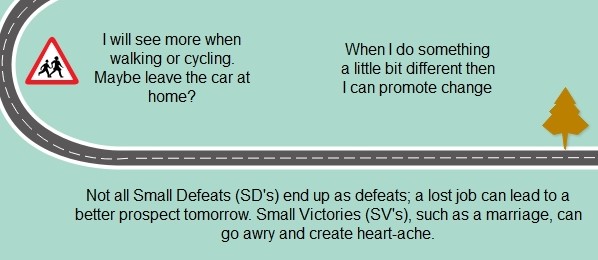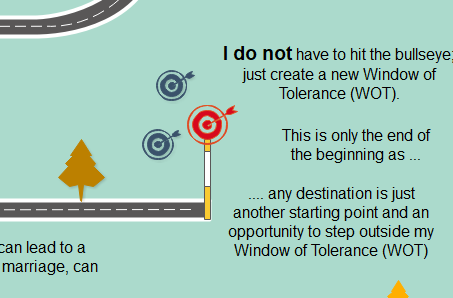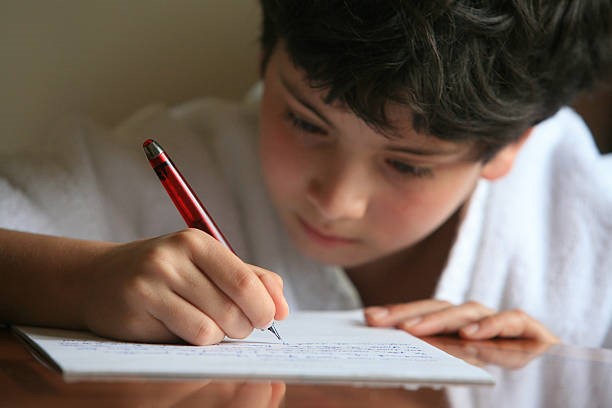Dear Reader,
Plenty of other people will want to nudge you
…… for gain (e.g. advertisers, profiteers and con artists)
…… for your own ‘good’ (e.g. by government)
……. out of love and affection (e.g. family and friends), misguided or otherwise
…… in writing to you in this way, I’m not so very different
…… but I want to give you first dibs, with the least sense of coercion
…… and I’m telling it to your face
…… and I am not after making you do anything in a subtle way.
Unlike Monty Python, this is not something completely different
IT IS SOMETHING JUST A LITTLE BIT DIFFERENT!!
This letter encourages you to review and supplement the large collection of small, safe experiments I have gathered. They come from my clients and colleagues over decades and they have been tried out over many years.
They offer many opportunities to do something a little bit different – this afternoon or, maybe, tomorrow morning.
As I say on the welcome page, no safe experiment always works, most things described here have worked, sometimes, for some people.
If this website is about anything, it provides you with an opportunity to decide what ‘treatment’ works for you.
Robin’s experiments and ‘real’ experiments??!
That said, there is at least one rather important difference between these small, safe experiments and real science or ‘medicine’: I realise that medicine cannot afford to get it wrong; people can die from poorly-prepared pills and procedures. Who remembers the Thalidomide scandal from the mid-20th century?
By contrast, the safe experiments described here can be better for us when they go wrong! Consider this extract from the scenic route:

This website asserts that a small defeat can be a valuable trigger to move us along the path toward effective change.
There is another important difference: doctors can help you without you knowing what’s involved. You can get better by simply doing as you are told: “take this tablet”. The small, safe experiments recorded here only work when you have a go and just notice you own response.
No-one else can do the work for you
If these experiments have anything to say, it is that you can only make the real difference for yourself. consider this advice from an agony aunt that makes sense to me! I believe you may be a little more in charge of your own fate than you think and you can make a difference under your own steam.
Here is a starter
During the ongoing public health crisis, my inverted tree and its concern for the New Normal was grasped with gusto. Let’s turn that catch-phrase into a small safe experiment.
Do it now by recalling your Old Normal. What was the theme in your life a few years ago?
Make brief notes about that past, keeping in mind that that history IS FOR INFORMATION ONLY.
Then consider your Present Normal. Any information about today describes what is happening NOW.
If you read on, you will come across NOW rather a lot. What do you notice about NOW, assuming you’ve jotted down some observations about it.
You need not read on if you are OK with Now. I may have little to offer you.
However, if there is just one thing that you would want to change, read on.
Because there are choices to be made when I seek to re-direct my energy in a different direction today. Change only comes when I do something different. The good news is that it can be something small.
I believe the experiments I offer may be of use to you. You may need to jiggle them a little (apologies to Ronnie Barker’s Arkwright). You are more likely to succeed if the small, safe experiment alters your way of life just a little.
Keep this in mind: what works for YOU?
Even if you think you do not have an answer to this enquiry, try out what is on offer. This website might jog your thinking – just enough.
Anyone with a natural curiosity will find ways to design and implement safe experiments.
PLEASE KEEP SOME NOTES about the things you do. I am not asking you to keep a journal or a diary. Effective experimenters have done perfectly well with bullet points and Post Its!
What makes this useful? Because you will, over time, create and develop your manual for change. You may need to refer to it from time to time. In the past, I have referred to this as My-Nual; that is, Your Manual!
A warning about small, safe experiments
Small, safe experiments are different from those used by conventional scientists. Scientists aims to repeat their experiments and get the same result; a good experiment is ‘replicable’; it turns out the same, time and time again. That makes the experiment reliable and credible.
Small, safe experiments, by contrast, often end up with a different result, at different times – to good effect! I assert that it’s OK for that to happen. It is a result.
Both forms of experimenting share one thing in common; the experiment does not exist without a result that is noticed.
Moving into small and safe experimenting
This website is designed so you can choose a page at random. You can design a safe experiment from most pages. Please keep in mind that, whatever happens, there is no ‘right’ or ‘wrong’; it’s not your fault if the result is unclear; nor is it my fault. It’s simply the result of the action taken. The key is to know what is learned from the outcome and what ‘something different’ might be tried next time.
Typically, those results will be:
- A small victory when the outcome means something to you.
- A small defeat when the outcome is confusing or most unexpected.
- Uncertain; when the outcome is puzzling; you have a suspicion that there is something there to grasp, but it is unclear.
Rules of Thumb
I have found a website saying similar things about ‘safe-to-fail’ experiments. Their five rules of thumb for experiments, minimally edited by me, go as follows:
1. Rally around a direction, not a destination. A destination is too narrow, whereas direction gives you a range to play inside. Note how illustration of ‘destinations’ on the scenic route give you room for manoevre.

2. Experiment at the edges. Change comes more easily at the edges than at the core. As you explore, you can develop your experiment. Here I would add that ‘exploring’ needs you to step outside your Window of Tolerance (WOT), not simply push at those edges.
3. Aim for the pragmatic. Think about what you can do within your span of control and can be operationalized fast.
4. Be playful – people want to join fun experiments.
5. Start small, and don’t obsess over the experience.
And a health warning
With the best will in the world, you may experience a large defeat on occasions. I cannot guarantee that this will not happen, especially as any actions can have unpredictable consequences. I cannot know what they will be, or how to side-step them.
Keep in mind, if you would, that the ‘the smallest little bit different’ can be elusive. Large defeats can arise from taking a risk that is, itself, just too big. Whenever you plan a safe experiment, ask yourself: is this the smallest step I can design? Be prepared to break down your plan even further.
So, what do you do about the small victory, the small defeat or the uncertain result.
- Small victories can be built on. They can give inspiration to take a next step.
- Small defeats need some examination. Review your experience and, hopefully, your written notes and ask: what might I have overlooked?
- Talk over the results with a trusted friend and see if a different pair of eyes has something to offer.
- Reconstruct a further safe experiment with a deliberate intention to include something just a little bit different next time around. Bear I mind that ‘next time round’ won’t be identical to ‘last time round’, so it’s important to keep your eyes open to the best possible, nearest thing.
- Keep in mind: as one swallow does not a summer make, so one result does not provide a final and definitive result. A picture may only emerge from a number of small victories or a combination of victories and defeats.
- Do anything that works – as long as it is safe and it can
Doing nothing is a decision
There is at least one other choice you have at hand: not to do any of the things I have suggested. That’s fine, as long as you are OK about living with the consequences. Doing nothing is a choice, it is an option and it has its own consequences.
Please remain aware that doing nothing is a decision; it is a default decision.
I do not want you to follow the nudges included here simply because I recommend them. Why is that? All the safe experiments in this book are built on other peoples’ experiences and ideas. There are a lot of them based on things others have tried. They may be helpful to you because they worked for some-one, somewhere. Some will not work for you; even the very best might not work for you. The timing for one nudge may not be quite right one day; another time, the same nudge may hit the nail on the head.
I want this information to help you recognise a nudge for what it is: your own prompt to action. When you design your own step it can lead to an improved ability to build on successes or adapt to unexpected/unwanted results.
Often adaptations are forced on us, as we discovered in the public health crisis of 2020/2021. Even then we still had some choices. We did not always see them or respond to them. That does not mean they were not there.
Best wishes
Robin Trewartha
THE END
…. hmm …. or just AN END?
….. maybe just ONE END
…. seems like PART of an END?
Oh, I know …… ONE OF SEVERAL ENDS

What does yours look like?
You could try ….
How to design safe experiments
